Weeping trees are trees characterized by soft, limp twigs. This characterization may lead to a bent crown and pendulous branches that can cascade to the ground. While weepyness occurs in nature, most weeping trees are cultivars. Because of their shape, weeping trees are popular in landscaping; generally they need a lot of space and are solitary so that their effect is more pronounced. The popular among the many weeping trees include:
- Weeping Pink Cherry or Weeping Higan
- Weeping Flowering Apricot
- Weeping Japanese larch
- Weeping Japanese maples
- Weeping Katsura
- Weeping mulberry
- Weeping Pagoda
- Weeping Willow
- Weeping Redbud Tree
- Weeping White Pine
- Weeping Norway Spruce
- Weeping Nootka Cypress
- Weeping Hemlock
- Weeping Birch Trees
- Weeping Beech Tree
- Weeping White Willow
- Camperdown Elm
- Inversa Spruce
- Weeping Copper Beech
- Weeping Crabapple
- Weeping Fig
- Weeping Tea Tree
- Cascade Falls Bald Cypress
- Weeping Atlas Cedar
Pink weeping cherry

The pink weeping cherry tree is a beautiful ornamental with arching branches which create a cascading fountain shape. In the spring, these are covered with delicate pink blossoms. In the summer months, they will be covered with glossy green leaves which gradually turn yellow as fall approaches. In the winter, its bronze bark stands out. Pink weeping cherry trees grow to be 20 to 30 feet tall at a rate of 1 to 2 feet per year, and require very little in the way of maintenance. The weeping cherry was derived from ornamental cherry trees from Japan. The tree can be full-size or dwarf.
Weeping Flowering Apricot
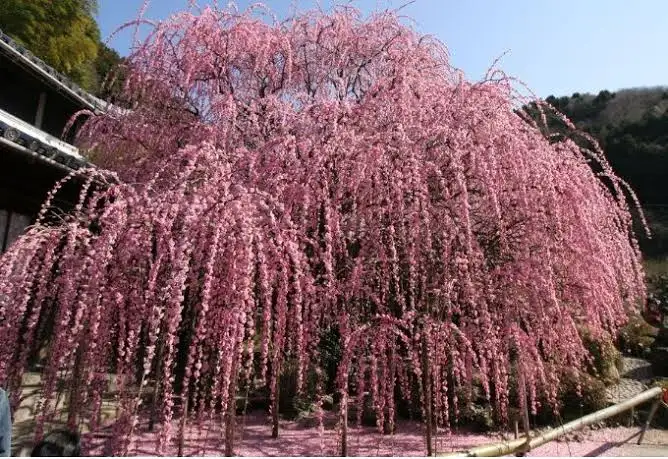
Weeping Flowering Apricot is a small tree with a weeping shape and rapid growth. The tree has a very pendulous branches that will weep all the way to the ground. It produces green foliage, turning bronze in autumn followed by double, light pink blossom in late winter to early spring. As a grafted weeper, it makes an outstanding feature in any garden.
Weeping Japanese Larch
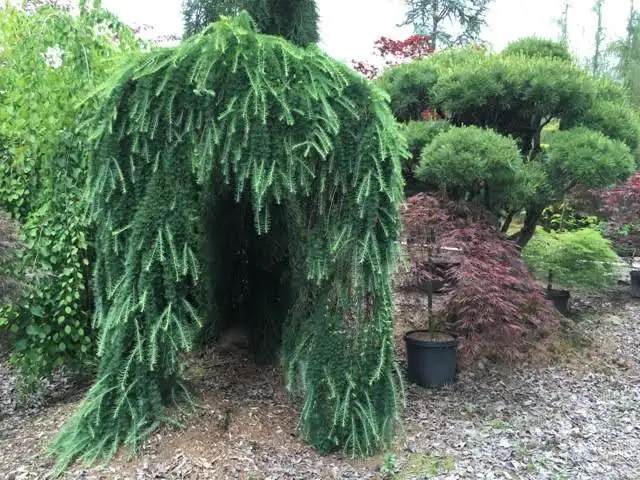
Weeping Japanese Larch is primarily valued in the landscape or garden for its highly ornamental weeping form. It has bluish-green deciduous foliage which emerges light green in spring. The needle-like leaves turn an outstanding gold in the fall. The rough brick red bark and gold branches are extremely showy and add significant winter interest. Weeping Japanese Larch will grow to be about 8 feet tall at maturity, with a spread of 4 feet.
Also Read: Different Types of Maple Trees
Weeping Japanese Maples

Weeping Japanese maples, sometimes called laceleafs are beautiful and offer versatility in the landscape and spectacular autumn color. Their branches seem to flow in the wind. The weeping Japanese maple cascade often in an umbrella shape that creates an oriental appeal and brings the feel of nature to your garden.This ornamental deciduous tree reaches 6 to 12 feet tall, spreading 9 to 15 feet wide. The leaves of Japanese weeping maple trees are deeply dissected, much more so than regular Japanese maples with erect growth habits. These trees are not only grown primarily for their decorative leaves, but they also exhibit red blossoms in the spring.
Weeping Katsura

The weeping katsura will bring character to your landscape all year long. It’s a great choice for gardens due to its compact shape and ability to provide light shade. Weeping Katsura can grow to heights of up to 15 to 25 feet, making it an ideal choice for parks and golf courses. The tree will initially take on a pyramidal form before rounding out. It’s pendulous branches fan out before sweeping the ground. It’s gorgeous foliage will emerge as bronze or purple-red before turning blue-green and fading to gold or apricot in the fall. In spring, tiny red flowers will emerge, although they are not particularly ornamentally interesting.
Weeping Mulberry

Weeping mulberry is a cultivar of the white mulberry (Morus alba). It grows to a height of 6 to 10 feet and a spread of 8 to 12 feet. Its canopy has a circular outline, with somewhat warped and curled branches that hang to the ground. These trees, for the most part, tend to grow rapidly. They often can handle many less-than-ideal growing circumstances, including city landscapes, and they flourish in partial shade and full sun. The rugged bark of the trees is unobtrusive, with basic brown coloring. When autumn rolls around, the deep-green leaves promptly become yellow.
Weeping Pagoda

The Weeping Pagoda tree, known sometimes as the Weeping Japanese Pagoda tree or the Weeping Chinese Scholar, is a beautiful ornamental tree of compact size. It’s stiff branches droop delicately forming picturesque weeping habit. The leaves have a light-coloured almost feathery appearance from a distance, and they turn a pretty yellow before they fall in the Autumn. Also, the cascading, sometimes twisted branches add grace to the garden and soft movement as the wind blows. These Weeping Pagodas are grafted varieties whivch means they will not grow beyond a total height of roughly 8-9ft. They are generally perfect for a small garden.
Weeping Willow
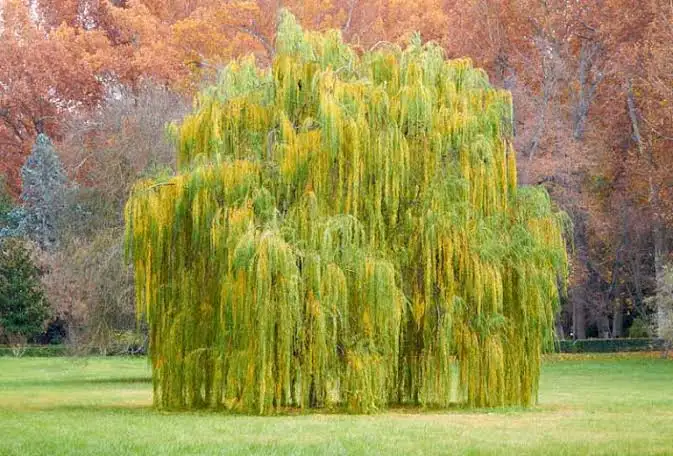
Weeping willow trees are probably the widely popular of the weeping trees due to their dramatic, elegant appearance. Their long, graceful branches “weep” into an arch, creating a round canopy that grazes the ground gently. Their narrow leaves are light green on top, with silvery undersides until they turn yellow in autumn.The weeping willow’s bark is rough and gray, with long, deep ridges. When the tree blooms in late winter or spring, yellow catkins (flowers) appear. Weeping willows are fast-growing trees, adding up to 10 feet per year when young, but their average lifespan is a relatively short 30 years.
Also Read: Different Types of Crabapple Trees
Weeping Redbud

The weeping redbud known as “Lavender Twist” was discovered in 1991 in western New York state. The gardener’s last name is Covey and so the tree is sometimes also known as the “Covey Eastern Redbud”. It was patented in 1998 and is now more widely available. Like the common eastern redbud, Lavender Twist redbud trees bear small, pea-like pink-purple flowers in early spring, before the tree leafs out. These flowers form all along the tree’s cascading, twisted branches and its trunk. The weeping branches and twisted shape make it an attractive tree for cottage gardens or for adding spring color.
Weeping White Pine
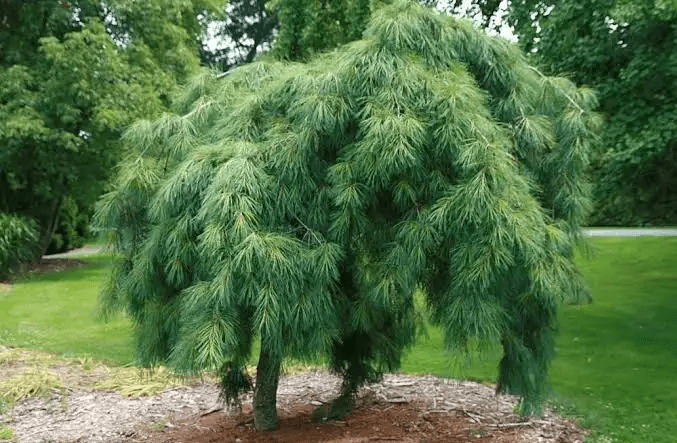
Weeping White Pine is a cultivar of the white pine family. It is a short multi-stemmed evergreen shrub with a rounded form and gracefully weeping branches. Its relatively fine texture sets it apart from other landscape plants with less refined foliage. Weeping white pine trees have smooth trunks covered with silvery-gray bark. The bark is attractive when the trees are young, but as they age, the foliage covers the trunks all the way to the ground. The weeping white pine has an attractive bluish-green evergreen foliage. The needles are highly ornamental and remain bluish-green throughout the winter.
Weeping Norway Spruce

Weeping Norway Spruce is an evergreen tree with a strong central leader and a rounded form and gracefully weeping branches. With supports, this tree can grow to 15 feet tall. Without support, the weeping Norway spruce is best suited as ground cover; it will trail across the garden and drape down rocks or walls. Weeping Norway Spruce is primarily valued in the landscape for its highly ornamental weeping form. Its rich green evergreen foliage emerges lime green in spring. The needles remain green throughout the winter.
Blue Weeping Nootka
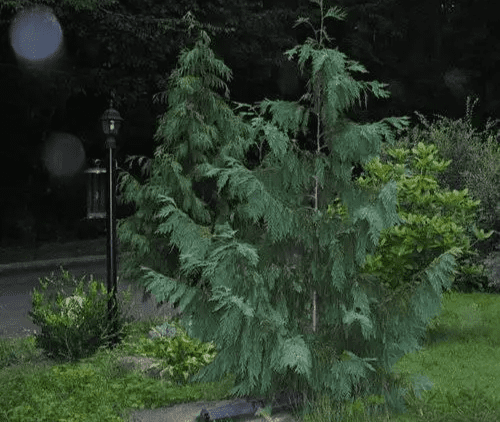
Blue Weeping Nootka Cypress will grow to be about 25 feet tall at maturity, with a spread of 12 feet. This cypress is primarily valued in the landscape for its highly ornamental weeping form. Weeping Nootka Cypress have a green-gray or blue-gray scaly foliage that gives off an odor when crushed. This cypress variety produces small seed cones that are 1/8 to 1/2 inch long. The scale-like sprays of foliage remain powder blue throughout the winter. The shaggy antique red bark adds an interesting dimension to the landscape. This variety of cypress requires little shaping for an attractive appearance.
Weeping Hemlock

Weeping Hemlock also referred to as Canadian Hemlock tree will grow to be about 10 feet tall at maturity, with a spread of 20 feet. This species is one of the more popular hemlocks planted in the eastern United States and Canada. Weeping hemlock displays spreading branches and dense foliage with a delicate, lacy texture. Weeping Hemlock is a dwarf conifer which is primarily valued in the landscape or garden for its highly ornamental weeping form. It has dark green evergreen foliage which emerges light green in spring. The needles remain dark green throughout the winter.
Also Read: Different Types of Evergreen Trees For Landscaping
Weeping Birch

Weeping Birch will grow to be about 40 feet tall at maturity, with a spread of 20 feet. These trees have a distinct growth habit, with their branches drooping downwards and heart-shaped to triangular foliage that provides multiple seasons of interest. The tree’s light yellow catkins hang lazily against its dark green leaves in the spring. These green leaves eventually turn a bright yellow in the fall. The peeling white bark is extremely showy and adds significant winter interest.
Weeping Beech

Weeping Beech will grow to be about 50 feet tall at maturity, with a spread of 50 feet. It is primarily valued in the landscape for its highly ornamental weeping form. It has rich green deciduous foliage. The serrated pointy leaves turn an outstanding coppery-bronze in the fall. The smooth silver bark is extremely showy and adds significant winter interest. Its average texture blends into the landscape, but can be balanced by one or two finer or coarser trees or shrubs for an effective composition.
Camperdown Elm
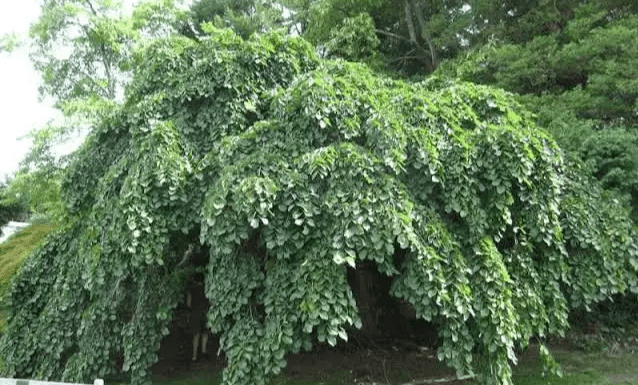
Camperdown is a weeping elm tree with gorgeous twisted branches and dense foliage. Its crown is domed and dense, and the twisted, root-like branches, thick with green foliage, droop to the ground if left unpruned. In spring, Camperdown weeping elm trees are covered with blossoms. Although the flowers are small and, individually, insignificant, many of them appear at the same time. When the entire dome is covered, the plant turns from dark green to light, silvery green.
Weeping Copper Beech
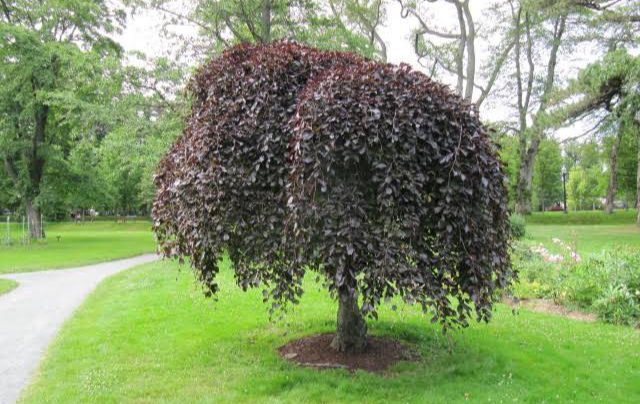
Weeping Copper Beech is a slow growing, deciduous weeping beech tree with a mushroom shaped head and purple foliage. The leaves are a shiny dark red-purple that appear in spring and eventually turning coppery in autumn. This beautiful weeping specimen tree is also named Weeping purple beech and will look stunning in any size garden. It will add beautiful colour from spring through to autumn.
Weeping Crabapples

Weeping Crabapples are known for downward-turning, cascading branches that display beautiful white or pink blossoms each spring. The bloom season is short-lived, often lasting just a few days up to two weeks. Weeping crabs are usually planted as potted nursery specimens or ball-and-burlap plants in the fall. They are generally smaller and slower-growing than standard crabapples, growing only about 6 inches per year, and it may take several years before they reach flowering maturity.
Also Read: Different Types of Christmas Trees To Try At Home
Weeping fig

Weeping fig commonly referred to as the ficus tree grows as a large broadleaf evergreen tree with slender branches that arch gracefully from a light gray trunk, with dense, glossy dark leaves. When grown indoors, the plants are normally pruned to keep them about 3 feet to 6 feet tall, and their trunks are sometimes braided for decorative appeal. It is a fast grower and may need to be repotted up to once per year, but do so in the early spring for best results.
Weeping Tea Tree
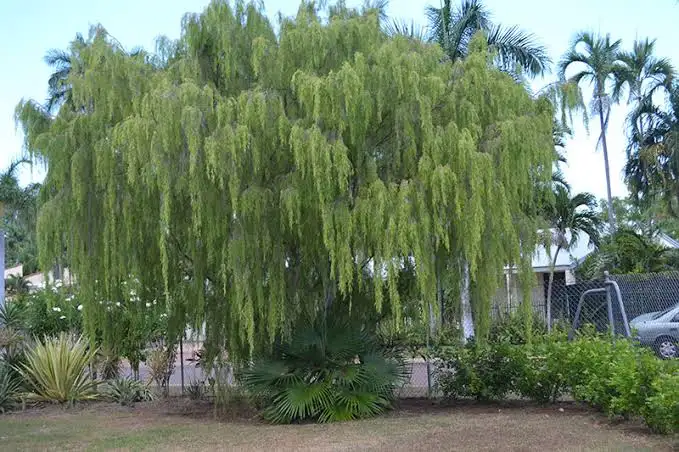
The Weeping Tea Tree is a native of New South Wales and Queensland. An evergreen tree with a weeping habit strongly resembling the weeping willow. It grows to 4 metres with a spread of 2 metres and has white flowers from Spring to early Summer.
Cascade Falls Weeping Baldcypress

Cascade Falls Weeping Baldcypress is an open deciduous tree with a strong central leader and a rounded form and gracefully weeping branches. It will grow to be about 20 feet tall at maturity, with a spread of 20 feet. This tree is primarily valued in the landscape for its highly ornamental weeping form. It has emerald green deciduous foliage. The ferny bipinnately compound leaves turn an outstanding orange in the fall. The shaggy antique red bark adds an interesting dimension to the landscape.
Weeping Atlas Cedar

The blue Atlas cedar is part of the Pinaceae (pine) family as well as the Cedrus genus, and grows slowly (less than a foot a year), eventually reaching heigh maturity after ten or so years. its drooping, twisted branches are filled with whorls of powdery blue needles, producing only a few small cones in the springtime. It can be trained and shaped as it grows and can be molded into cone, oval, cylinder, or “weeping” shapes.
Further References
- Beautiful Weeping Trees: https://www.thespruce.com/what-are-weeping-trees-3269676
- Types of Weeping Trees: https://www.gardeningknowhow.com/ornamental/trees/tgen/common-weeping-trees.htm
- Weeping Trees: https://www.fast-growing-trees.com/collections/weeping-trees
- Facts About Weeping Trees: https://en.m.wikipedia.org/wiki/Weeping_tree